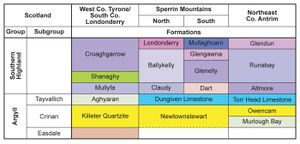Dalradian Supergroup, Central Highlands (Grampian) Terrane, Northern Ireland
| Mitchell, W I (ed.). 2004. The geology of Northern Ireland-our natural foundation. Geological Survey of Northern Ireland, Belfast. |
M R Cooper and T P Johnston
Introduction



Most of the Central Highlands (Grampian) Terrane in Northern Ireland consists of mid- to late Neoproterozoic rocks of the Dalradian Supergroup which extend from the east coast of Scotland to the Atlantic coast of Co. Donegal. In Northern Ireland the rocks crop out in the Sperrin Mountains, Lack Inlier and northeast Co. Antrim (P947791) . The regional fold structures that affect the Dalradian rocks here and in Scotland seem to be of similar structural age and disposition (P947793) .
Stratigraphy
The thick succession of predominantly clastic marine sediments that now forms the rocks of the Dalradian Supergroup was deposited in a rift basin. They are divided into the Argyll Group and the Southern Highland Group (P947914). In addition to the correlation with successions in Scotland wider correlations have also been made between the Dalradian Supergroup and the Fleur de Lys Supergroup in Newfoundland [1].
The rocks in the Argyll Group provide evidence of changing tectonic and depositional conditions at the Laurentian margin. The initial relatively stable shelf environment, which prevailed here during deposition of the Crinan Subgroup (P947914), gave way to more unstable conditions. Between 700–600Ma, prior to the opening of the Iapetus Ocean, regional instability resulted from the separation of Laurentia from Baltica. Evidence of crustal stretching and thinning is found in major facies changes in the Tayvallich Subgroup (P947914) in particular the appearance of metabasite (dolerite) intrusions and submarine pillow lavas that reflect upsurges of basaltic magmatism. This magmatism, and the erosion of basic igneous rocks along the continental margin, was closely associated with the formation of contemporaneous volcaniclastic sediments (green beds) that are confined to a narrow stratigraphical interval in the upper part of the Argyll Group and lower part of the Southern Highland Group.
The Southern Highland Group consists mainly of turbidites that were deposited in a tectonically unstable off-shelf environment. The basal part consists mainly of coarse-grained proximal arenites, with green beds, which pass upward into a very thick succession of finer grained lithologies of the outer fan depositional environment.
Reference
- ↑ Kennedy, M J. 1975. The Fleur de Lys Supergroup: stratigraphic comparisons of Moine and Dalradian equivalents in Newfoundland and the British Caledonides. Journal of the Geological Society, London, 131, 305–10.